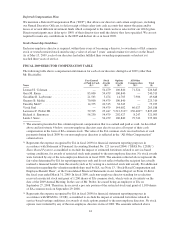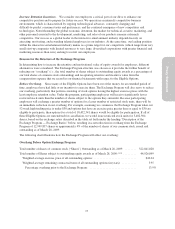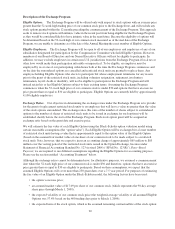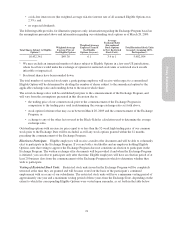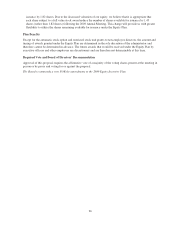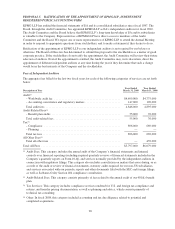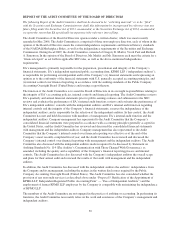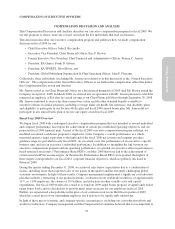Electronic Arts 2009 Annual Report Download - page 31
Download and view the complete annual report
Please find page 31 of the 2009 Electronic Arts annual report below. You can navigate through the pages in the report by either clicking on the pages listed below, or by using the keyword search tool below to find specific information within the annual report.
Proxy Statement
restricted stock award would be entitled to vote those shares, as they are outstanding shares of common stock.
Restricted stock units represent rights to receive shares of common stock on specified future dates when those
rights have vested following a required period of employment. A recipient of a restricted stock unit does not have
voting rights, as the shares of common stock are not issued until the restricted stock unit vests. Any restricted
stock awards issued as part of the Exchange Program will be issued on the date the Eligible Options are
cancelled, will be subject to the same exchange ratios as the restricted stock unit issuances, and will vest in same
manner described above for new restricted stock units granted in exchange for surrendered Eligible Options.
Summary of United States Federal Income Tax Consequences
We believe the exchange of Eligible Options for restricted stock units pursuant to the Exchange Program should
be treated as a non-taxable exchange and that we, our stockholders and employees should recognize no income
for United States federal income tax purposes upon the surrender of Eligible Options and the grant of restricted
stock units. When the restricted stock units vest according to the vesting schedule above, and shares of common
stock are issued to the employees, the shares issued will be subject to US income and employment taxes and
applicable income and employment taxes will be withheld. To comply with our withholding requirements, we
will withhold shares, provided that we will only withhold a number of shares with a fair market value equal to or
below the applicable minimum withholding amounts. In order to avoid issuing fractional shares, we may round
up to the next nearest number of whole shares as long as we issue no more than a single whole share in excess of
the minimum withholding obligation.
The preceding paragraph is merely a summary of the anticipated material United States federal income tax
consequences of participating in the Exchange Program and of holding restricted stock units. A more detailed
summary of the applicable tax considerations to participants will be provided in the Offer to Exchange. The
Internal Revenue Service is not precluded from adopting a contrary position and the law and regulations
themselves are subject to change. The tax consequences of the Exchange Program and the receipt of restricted
stock units under the Equity Plan for participating non-United States employees may differ significantly from the
United States federal income tax consequences described above. All holders of Eligible Options are urged to
consult their own tax advisors regarding the tax treatment of participating in the Exchange Program under all
applicable laws prior to participating in the Exchange Program.
Accounting Treatment
Effective with our fiscal year commencing on April 2, 2006, we adopted the provisions of SFAS No. 123(R),
which requires us to estimate the fair value of share-based payment awards. Under SFAS No. 123(R), to the
extent the fair value, for accounting purposes, of each award of restricted stock units granted to employees
exceeds the fair value, for accounting purposes, of the stock options surrendered, such incremental amount is
considered additional compensation. We currently expect to incur a non-cash compensation charge of
approximately $65 million to $85 million over the vesting period of the restricted stock units (approximately one
to three years) in addition to recognizing any remaining unrecognized expense for the stock options surrendered
in exchange for the restricted stock units. In determining the fair value of the stock options surrendered for
purposes of determining the exchange ratios, we used the remaining life of the option as the expected term in our
Black-Scholes valuation model, rather than the expected term calculated in accordance with SFAS No. 123(R),
which requires us to estimate when the option will be exercised or cancelled after vesting. While we designed the
Exchange Program to fall within the guidelines for a “value for value” exchange, we determined that structuring
the Exchange Program also to be accounting neutral (i.e., so it would not require that we incur an additional
compensation charge) would result in exchange ratios that would be extremely unattractive for our employees
and would result in low participation rates that would undermine the purpose of the Exchange Program. The
amount of actual non-cash compensation charge will depend on a number of factors, including:
• the level of participation by Eligible Option holders in the Exchange Program,
• the exercise price per share of Eligible Options cancelled in the Exchange Program,
• the expected term of the Eligible Options cancelled in the Exchange Program,
• our stock price at the time of the Exchange Program,
23



